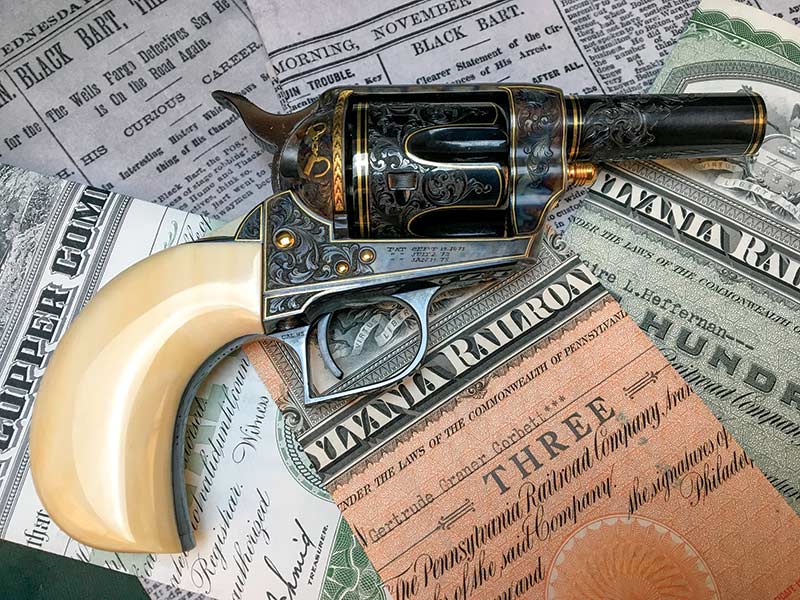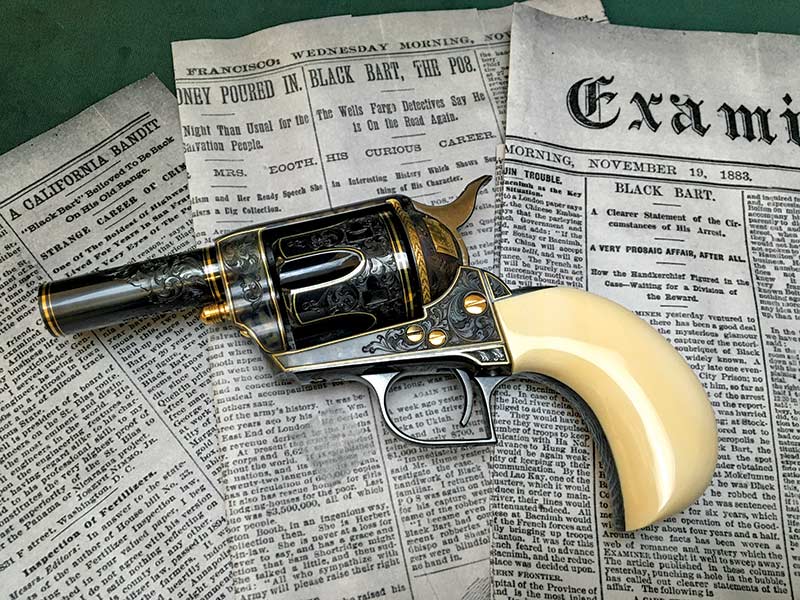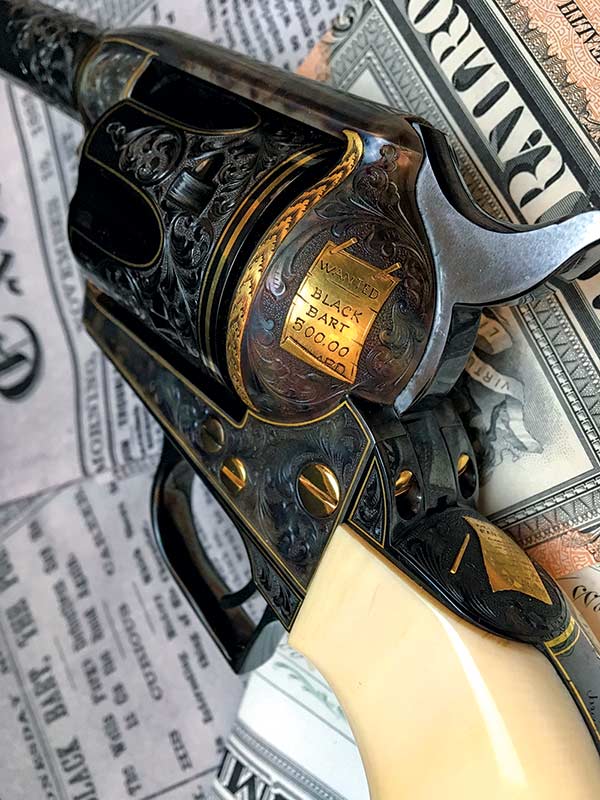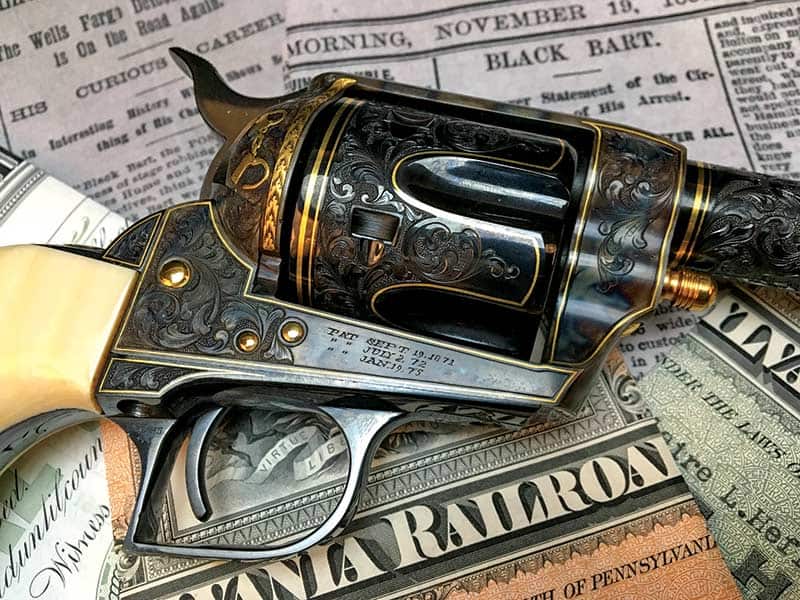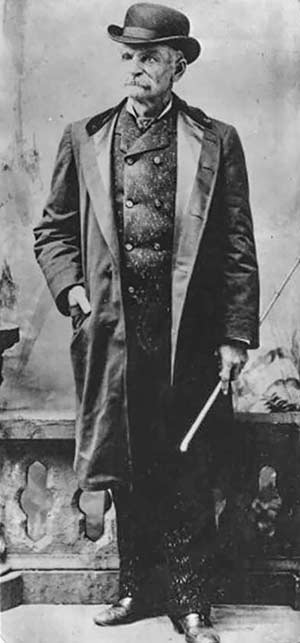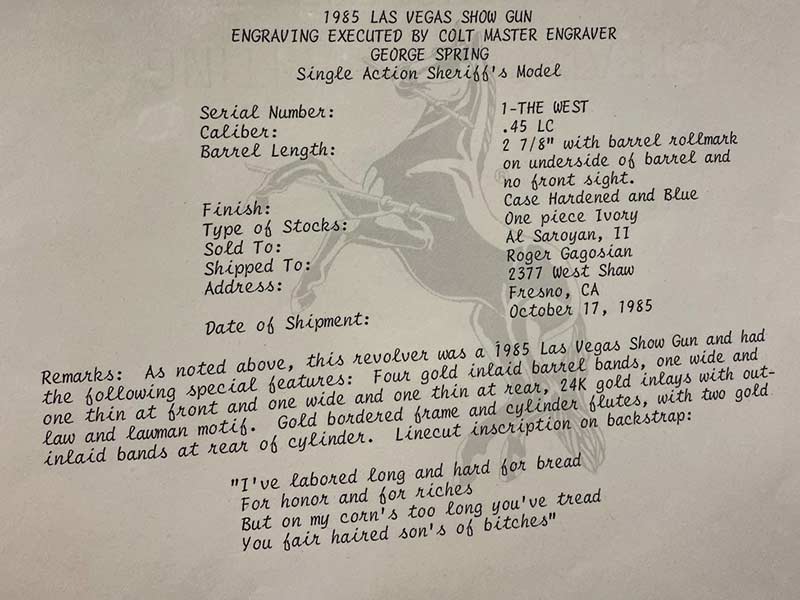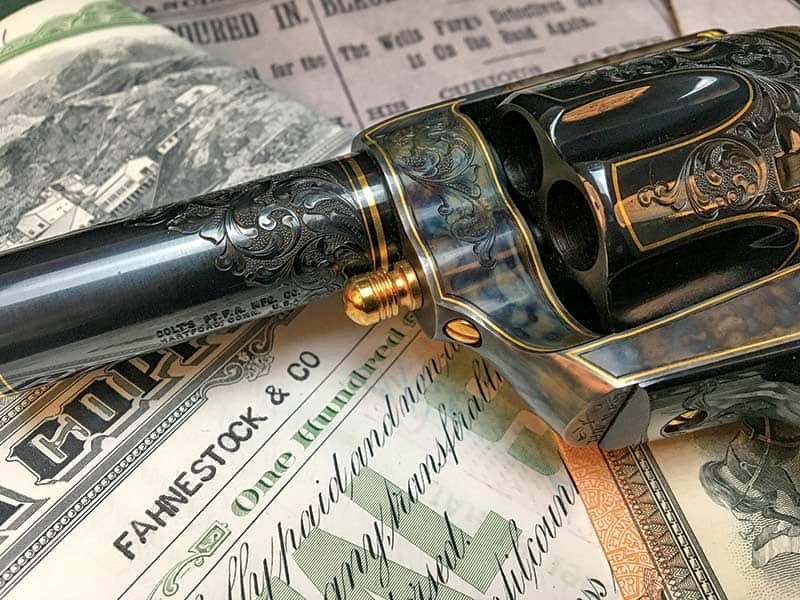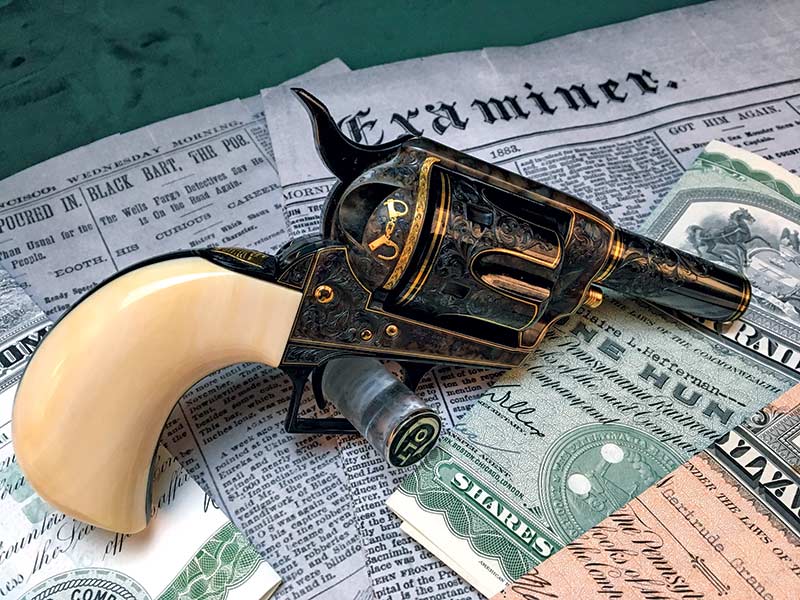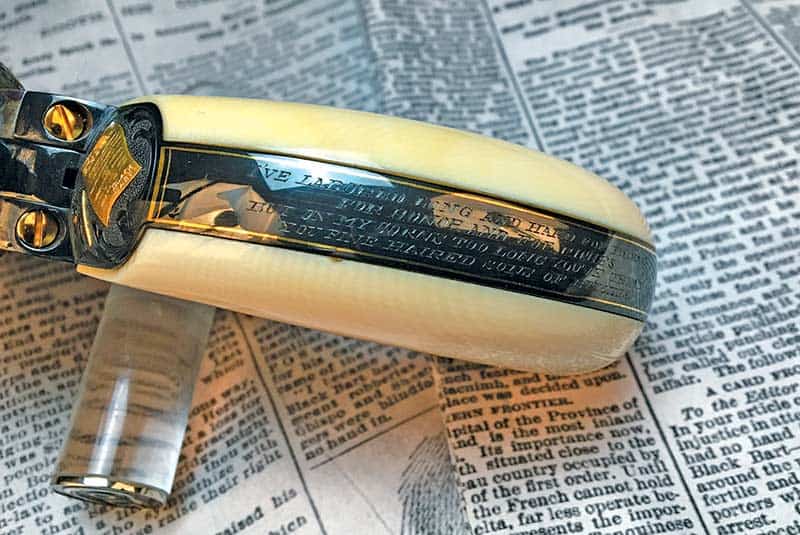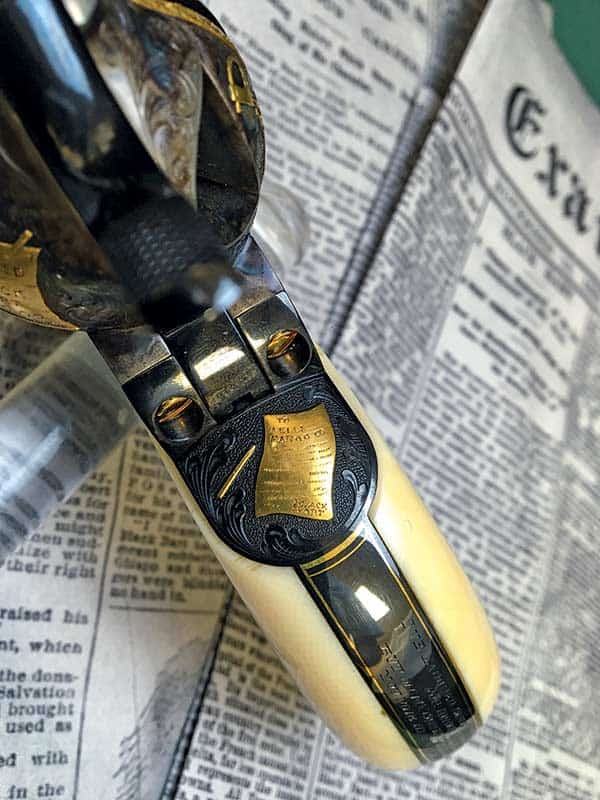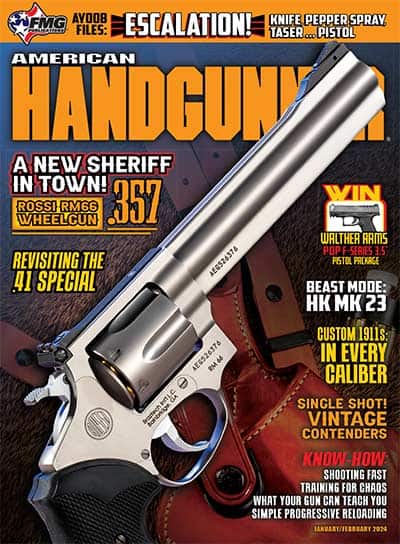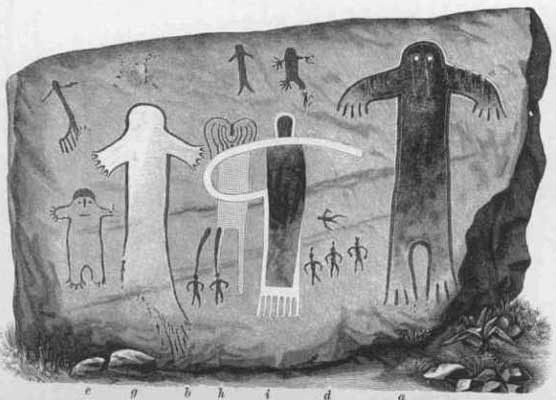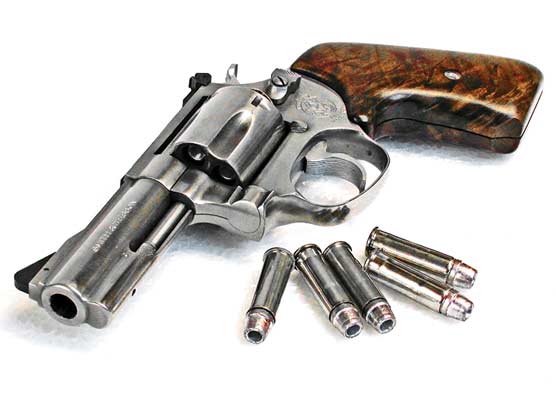The Black Bart Colt
A Masterpiece In Steel And Ivory
Black Bart is one of the few Old West outlaws known by name, if not in legend. It’s for a good reason. For eight long years, Black Bart was the bane of Wells Fargo, robbing a shocking 28 stages of their strong boxes, all without shooting anyone.
The legend started on July 26, 1875, as a stage traversed a remote pass four miles east of Copperopolis, Calif. A lone figure stepped out before the stage and leveled a double-barrel shotgun at the guard. The bandit was cloaked in a long dirty duster and wore a flour sack over his face with holes for his eyes. “Please, throw down the box!” Turning to the brush beside the road, he called out, “If he dares shoot, give him a solid volley, boys.” To the driver’s horror, multiple gun barrels were trained upon him and the stagecoach. The driver complied and told the passengers to do as the bandit requested. A woman threw out her purse, but the bandit swept it up with a flourish and returned it to her, “Madam, I do not wish your money. In that respect, I honor only the good office of Wells Fargo.”
The hooded man motioned the stage driver to move on. After a bit, they returned to investigate the crime scene only to realize the rifles were still pointed at them. Then they noticed the rifles were sticks set up to look like firearms!
Bandit Poetry
The stage robberies continued. In most cases, the stage was stopped as it slowed for a dangerous section of road in the mountains. The bandit was always on foot. And he was always courteous, especially to women.
If robbing 29 coaches didn’t cement Black Bart’s place in history, his habit of leaving taunting poems did. On August 3, 1877, Black Bart struck again, but this time he left what would become his most famous poem.
I’ve labored long and hard for bread,
For honor, and for riches,
But on my corns too long you’ve tread,
You fine-haired sons of bitches.
— Black Bart, the P o 8
The P o 8 reference mystified investigators until they read it phonetically as “poet”.
There were poems to follow, but some historians feel only one more was authentic. It came on July 25, 1878, when Black Bart robbed the Quincy to Oroville stage.
To wait the coming morrow,
Perhaps success, perhaps defeat
And everlasting sorrow.
Yet come what will, I’ll try it once,
My conditions can’t be worse,
But if there’s money in that box,
It’s munny in my purse.
— Black Bart, the P o 8
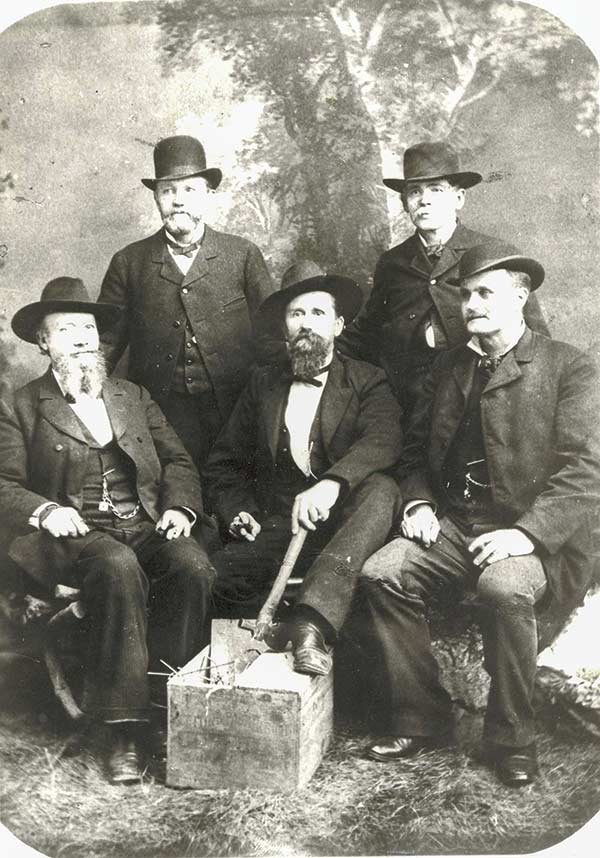
Black Bart’s arresting officers pose with his hatchet used to chop open
strong boxes. Back, left to right: Captain Stone of the Central Pacific Railroad
and Wells Fargo Detective John Thacker. Front, left to right: San Joaquin County
Sheriff Tom Cunningham, Sheriff of Calaveras County Ben Thorn, and Wells Fargo
Detective Harry Morris.
Photo credits: The Calaveras County Historical Society.
The Chase Is On
Every robbery was the same. It was always a remote location with no evidence left behind. It was as if the bandit evaporated into thin air as soon as the Wells Fargo box was emptied. It was even rumored Black Bart was a ghost.
Black Bart was a thorn in the side of Wells Fargo. It was a black mark on their record and cutting into their profits. Pulling out the stops to catch the ghostly bandit didn’t take long.
Black Bart’s final robbery occurred at the exact location as his first. The stage was empty this time but was carrying some $4,800 in gold and coins. The stories vary a little, but all agree the stage driver had a young man with him who wanted to go deer hunting. The driver had just dropped the hunter off when Black Bart stepped out. The bandit ordered the driver to throw down the box. The driver stated he could not, as it was bolted to the floor of the coach. Black Bart had the driver unhook the team and head down the road as he commenced chopping at the box to gain access.
As the driver watched Black Bart work on the Wells Fargo box, the young hunter came into view, unknown to Black Bart. The stage driver motioned the hunter over. Once united, they fired at the bandit, sending him fleeing with the gold, but not before wounding him.
When investigators arrived, they found many personal items of the bandit and one important clue: a handkerchief with a laundry mark. Not long after, the Wells Fargo detective had traced their man through a laundry mark. Black Bart was captured!
Black Bart … Revealed
Black Bart was really a man many considered a gentleman and a dandy named Charles E. Boles. He was known as a man that enjoyed the finer things, all at the expense of Wells Fargo!
Some may ask why someone would specifically go after Wells Fargo. Later, letters revealed Boles had been gold mining in Montana when Wells Fargo agents forced him off his legal claim. Bitterness and revenge may have driven his quest to gain the riches he had been cheated out of in Montana. Considering he withdrew $18,000 from the “Bank of Wells Fargo” over eight years, one could say he got his revenge.
While Boles never officially admitted to being Black Bart, he claimed his shotgun was never loaded because he didn’t want to hurt anyone.
Boles was a model inmate and was released from San Quentin Prison in 1888 after only serving just over four years of his six-year term.
At his release, reporters mobbed him, asking if he would resume robbing stagecoaches. He replied he was a reformed man and would no longer commit any crimes. One reporter asked if he was going to write any more poetry. Jokingly, he replied, “Did you not hear me say I would commit no more crimes?”
Like any good story, rumors grew, stating Black Bart returned to robbing stages, and Wells Fargo offered him $200 a month to leave their coaches alone. Most historians consider this false as no records were ever found
Commemorative Colt
The Colt SAA Sheriff’s Model shown was commissioned for the 1985 Las Vegas Gun Show, one of the premier gun shows in the country.
The engraving and inlay were performed by Colt Master Engraver George Spring. Colt employed Spring from 1975 to 2014 and is considered one of the greats in the field.
The artwork highlights some of the key points in the story of Black Bart.
A wanted poster proclaiming a $500 reward is on the left side of the recoil shield.
A set of manacles is on the right side of the recoil shield.
An example of Black Bart’s poems left at the crime scene is on the top of the back strap.
Black Bart’s first poem is linecut on the curve of the back strap.
The Black Bart Colt is a breathtaking gold and steel work of art worthy of any collection. It doesn’t take much imagination to think if Black Bart could reach through the mists of time, he would go to great lengths to stop any stagecoach carrying it.
Colt SAA Sheriff’s Model
Serial number: 1-THE WEST
Caliber: .45 Colt
Barrel: 27/8” with roll marks on the underside;
no front sight.
Frame: Black powder-style with gold-plated cylinder pin retention screw.
Finish: Case hardened and bluing. Features gold inlaid barrel bands, gold inlaid border on the frame, cylinder, trigger guard, and back strap. Gold Wells Fargo and Black Bart-related reliefs on the recoil shield and back strap. Scroll engraving is found on all major components. Gold plating is found on the screws and cylinder pin.
Engraving: Level C to D coverage.
Stocks: One-piece ivory

